 In each succeeding term the coefficient is found by multiplying the coefficient of the preceding term by the exponent of a in that term, and dividing by the number of the preceding term. In each succeeding term the coefficient is found by multiplying the coefficient of the preceding term by the exponent of a in that term, and dividing by the number of the preceding term.  The elements of algebra - Page 339by Andrew Bell (writer on mathematics.) - 1839Full view The elements of algebra - Page 339by Andrew Bell (writer on mathematics.) - 1839Full view - About this book
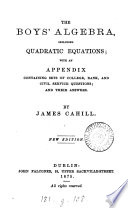 | James Cahill (of Dublin.) - Algebra - 1875 - 230 pages
...the expansion, and diminish from that to 1 at the end. V. The coefficient of any term after the first is found by multiplying the coefficient of the preceding term by the index of x in that term, and dividing the product by the number of that term, that is, the number denoting... | |
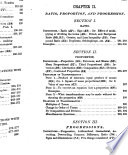 | Edward Olney - Algebra - 1877 - 466 pages
...expansion is unity ; of the second, the exponent of the required power; and tliat of any other term may be found by multiplying the coefficient of the preceding term by the exponent of the first letter in that term, and dividing the product by the exponent of the second letter + 1. SameU«<»*... | |
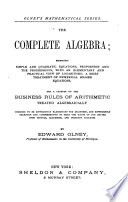 | Edward Olney - Algebra - 1878 - 516 pages
...expansion is unity ; of the second, the exponent of the required power; and that of any other term may be found by multiplying the coefficient of the preceding term by the exponent of the first letter in that term, and dividing the product by the exponent of the second letter + 1. DEM.—... | |
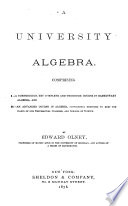 | Edward Olney - 1878 - 360 pages
...expansion is unity ; of the second, the exponent of the required power ; and that of any other term may be found by multiplying the coefficient of the preceding term, by the exponent of the first letter in that term, and dividing the product by the exponent of the second letter + 1. 190.... | |
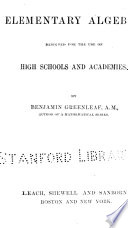 | Benjamin Greenleaf - Algebra - 1879 - 350 pages
...first term is one ; that of the second term is the same as the exponent of the power ; and, in general, the coefficient of any term is found by multiplying...the preceding term by the exponent of the leading letter of the same term, and dividing the product by the number which marks its place. NOTE 1. "When... | |
 | Benjamin Greenleaf - Algebra - 1879 - 322 pages
...is the same as the exponent of the power ; and. in ifenerul, the coefficient of any term is found h/ multiplying the coefficient of the preceding term by the exponent of the leading letter of the same term, and dividing the product by the number which marks its place. NOTE 1. When... | |
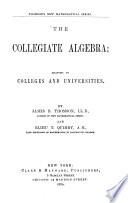 | James Bates Thomson, Elihu Thayer Quimby - Algebra - 1880 - 360 pages
...power. IV. The coefficient of any term (after the first, whose coefficient is i) is the product of the coefficient of the preceding term by the exponent of the leading letter in that term, divided by the exponent of the following letter in the term itself. V. The number... | |
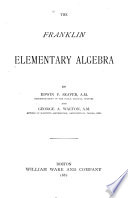 | Edwin Pliny Seaver, George Augustus Walton - Algebra - 1881 - 304 pages
...That the co-efficient of the first term is 1 ; and the co-efficient of any term after the first may be found by multiplying the co-efficient of the preceding...of the leading quantity in that term, and dividing the product by the number of terms that precede the required term. 248. These statements are embodied... | |
 | Edward Olney - Algebra - 1882 - 358 pages
...expansion is unity / of the second, the exponent of the required power ; and that of any other term may be found by multiplying the coefficient of the preceding term by the exponent of the first letter in that term, and dividing the product by the exponent of the second letter + 1. 190.... | |
 | Charles Davies - Algebra - 1889 - 330 pages
...2. LAW OF COEFFICIENTS. The coefficient of the first term is 1 y the coefficient of any succeeding term is found by multiplying the coefficient of the preceding term by the exponent of the leading letter in that term, and dividing the product by the number of terms preceding the required term. Let... | |
| |